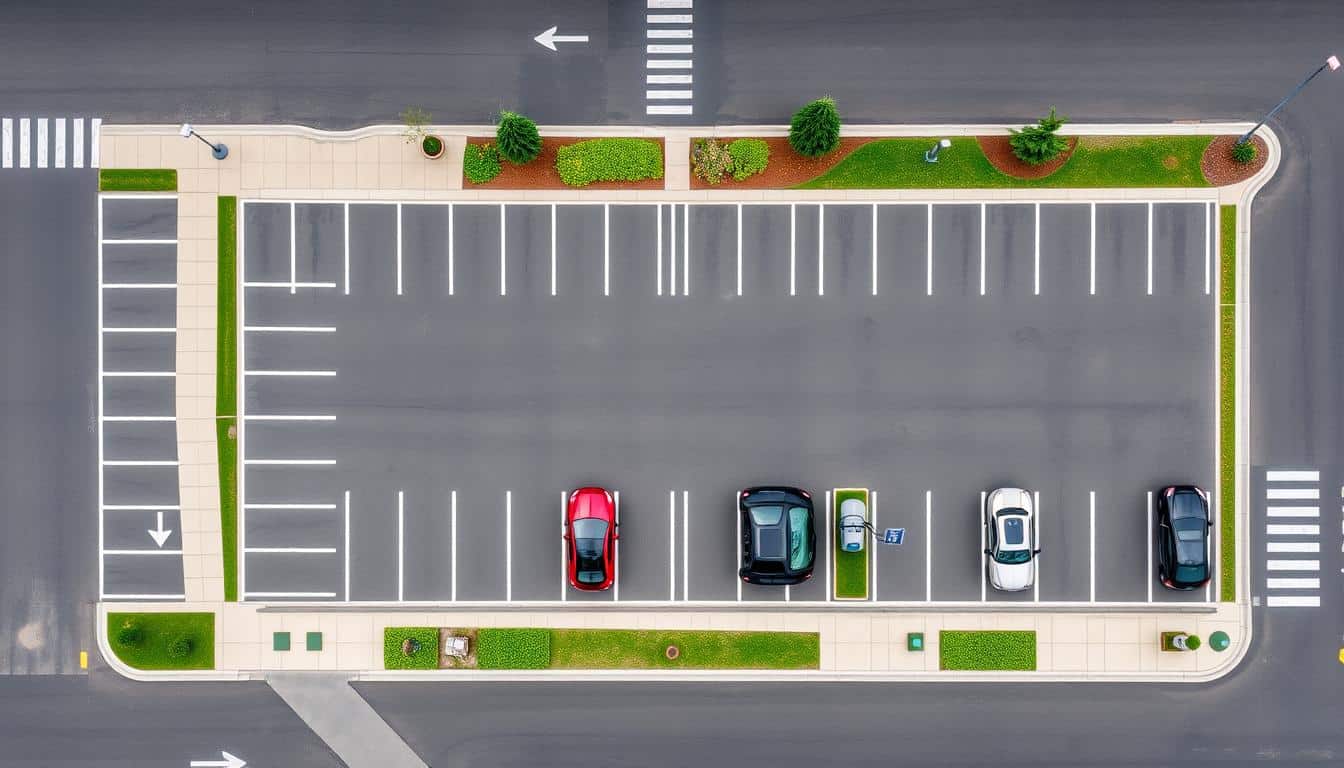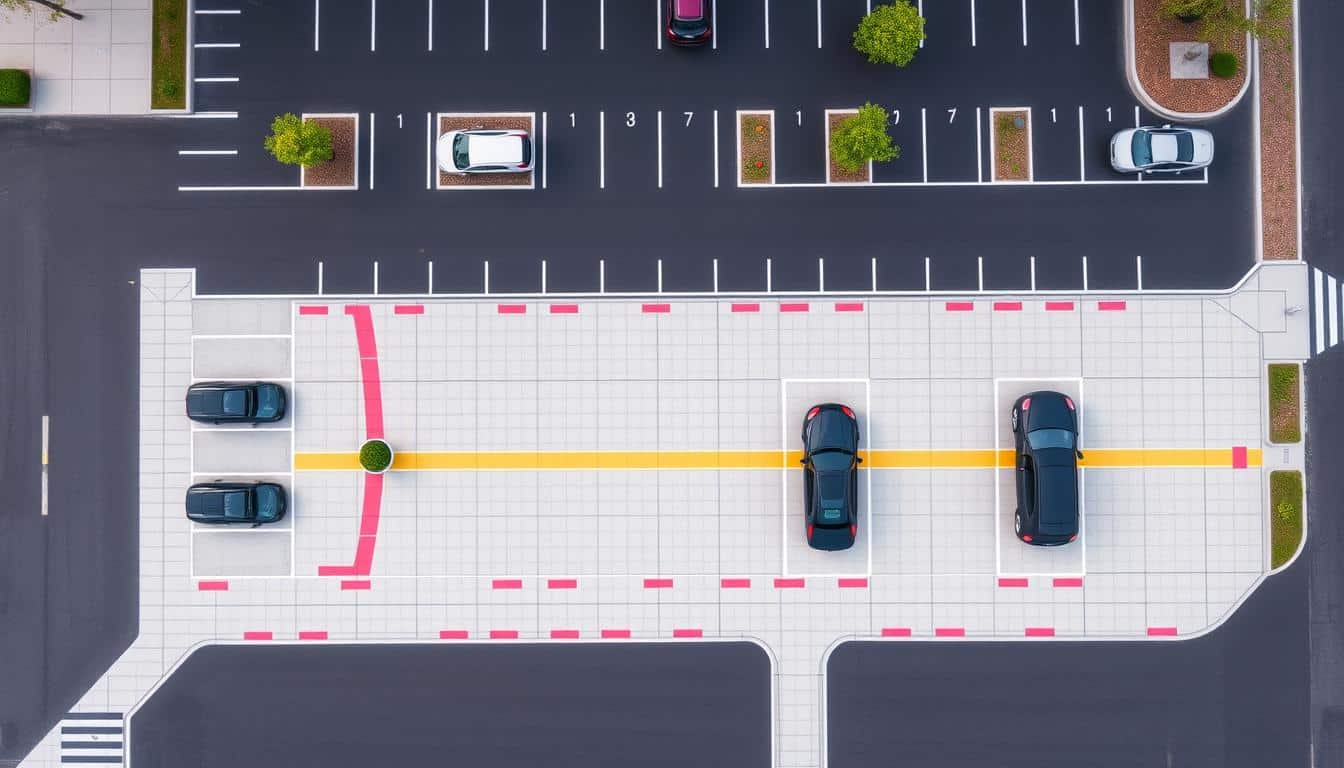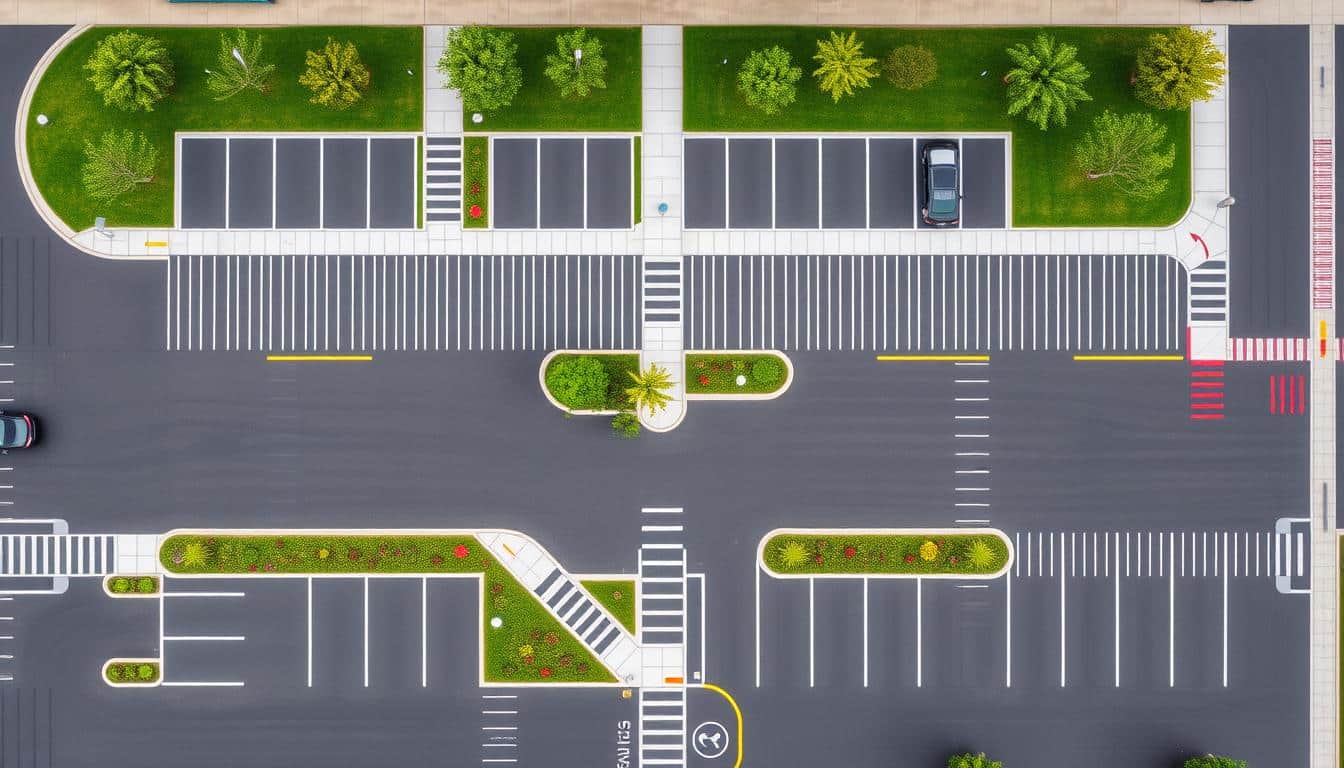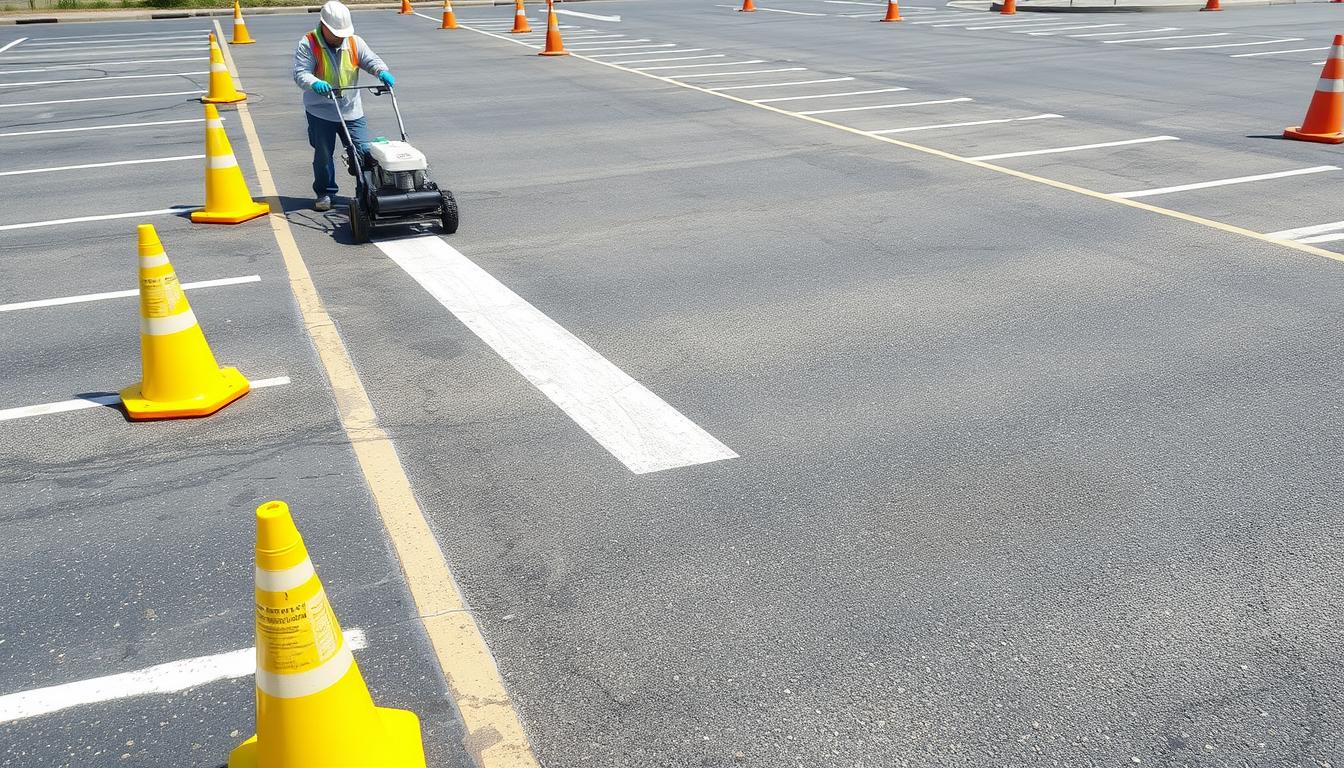Have you ever thought about how parking lot layouts affect your daily life? What are The Best Practices For Designing Parking Lot Layouts? Designing an efficient parking lot is more than just making it convenient. It shapes the user’s journey, impacts business foot traffic, and affects safety. In this article, we’ll explore the best practices for designing parking lots.
We’ll see how to use space wisely and create a welcoming, safe environment. Understanding the key elements of parking lot design is essential. It helps create a parking lot that benefits everyone.
Key Takeaways
- Standard dimensions for public parking spaces are typically 9’x18’.
- Accessible parking spaces must be located within 50 feet of facility entrances for improved convenience.
- Good signage can reduce the average time spent searching for parking by up to 30%.
- Proper drainage systems are essential to prevent water accumulation and ensure safety during rainy weather.
- Well-designed parking lots can increase return-on-investment (ROI) by 15-25% through optimized layout and efficiency.
- Providing adequate lighting can decrease crime rates by as much as 50%, improving pedestrian safety.
Understanding the Importance of Parking Lot Design
Parking lot design is more than just looks. It greatly affects how users feel and how well the space is used. Over 70% of parking lot accidents happen when people are parking or leaving. So, it’s key to have clear paths and signs.
Features like well-laid-out paths and clear signs make it easier to navigate. This reduces frustration for users.
Enhancing User Experience
Improving parking facilities starts with a few important things. Good lighting is one of them. It makes 87% of users feel safer.
Color-coded spaces help people find their cars quickly. This makes the experience smoother. Clear signs can cut down the time spent looking for a spot by up to 30%.
This is important because happy customers stay longer and spend more.
Maximizing Space Efficiency
To make the most of parking space, we need creative ideas. Shared parking can fit 20-30% more cars during busy times. Landscaped areas not only look good but also cool down the area by up to 50%.
It’s also important to have parking spots for everyone, as the ADA requires. Using smart tech to show where spots are available makes parking better for all.

Key Considerations for Layout Design
Creating an effective parking lot design is key for both function and safety. When planning, it’s important to think about traffic flow, parking stall setup, and emergency access. A well-thought-out approach to these areas can make parking better and reduce traffic jams.
Traffic Flow Patterns
Understanding how traffic moves is the first step in designing a good parking lot. In cities, 45° and 60° angled parking is popular because it saves space and reduces traffic. Using one-way lanes helps vehicles move smoothly, making parking safer and more efficient.
It’s also important to have wide paths for emergency vehicles. This ensures that first responders can quickly reach any area they need to.
Parking Stall Configuration
The way parking stalls are set up is another key factor. A standard stall is about 9 feet by 18 feet. In busy areas, it’s important to have clear paths between stalls. The lines marking parking spaces should be 12-20 mm wide for easy visibility.
For accessible parking, it’s vital to have two spaces near building entrances. These should be marked with signs at 2100 mm high for clear visibility.
Emergency Access Routes
Designing accessible emergency routes is essential. There needs to be enough space for emergency vehicles to move freely. Clear signs and paths help both regular and emergency traffic.
A good layout ensures vehicles can leave quickly and safely in emergencies.
Safety Measures in Parking Lot Designs
Keeping parking lots safe is key, given the high number of car accidents. Over 50,000 crashes happen every year in these areas. It’s important to focus on making them safer.
Good visibility and clear signs are key to reducing risks. They help prevent accidents.
Proper Lighting Solutions
Lighting is a must in parking lots, more so at night. The best light color is between 4000K and 5000K for clear visibility. Motion-activated lights in less busy spots save energy and keep things safe.
It’s vital to check the lights often. Dark spots can lead to accidents.
Signage and Markings
Clear signs and markings are essential for safety. They must follow ADA rules, with at least one in six spots being van-accessible. Bright striping and reflective paints help see better and cut down on accidents.
Marked crosswalks can lower pedestrian accidents by 60%. Regular checks on signs and markings are needed to keep the area safe.
Integrating Accessibility Features
Creating an inclusive parking lot design is key. It must follow ADA standards. The ADA sets rules for the number of accessible parking spaces. For example, lots with 1 to 25 spaces need at least one accessible space. Lots with up to 100 spaces must have four.
It’s not just about the number of spaces. The size matters too. Accessible parking spaces must be 96 inches wide. Van-accessible spaces need an extra 96-inch wide access aisle.
ADA Compliance Standards
Accessible spaces should be close to building entrances. They should use the shortest route. Van-accessible spaces need enough vertical clearance for larger vehicles.
Regular checks are vital to keep spaces accessible. Faded paint and blocked aisles can lead to fines and legal costs. Clear signs with the International Symbol of Accessibility are essential for guiding users.
Designing for Different Vehicle Sizes
Designing for various vehicle sizes is important. Regular parking spaces fit compact cars, while RV parks need wider spaces. The ADA requires at least one van-accessible space for every six accessible spaces.
Community facilities and RV parks must have wide pathways. They should include curb cuts for easy navigation. These features make spaces inclusive for all, ensuring safe and convenient access.
Environmental Considerations in Parking Lots
Designing parking lots with the environment in mind is key to sustainability. By adding green spaces and managing stormwater, we can help both nature and our cities. These steps improve air quality, lower temperatures, and make places more welcoming.
Incorporating Green Spaces
Green spaces in parking lots help fight the urban heat island effect. Plants cool the area, making it more pleasant. Native trees are great because they need less water and care.
These green features make parking lots more comfortable. They also help the local ecosystem.
Stormwater Management Solutions
Good stormwater management stops runoff and erosion. Permeable surfaces soak up water, helping groundwater. Rain gardens and trenches control runoff well.
A well-designed parking lot uses water wisely. By using stormwater management, we protect the environment and the parking lot itself.

Choosing the Right Materials
Choosing the right materials for a parking lot is key for its performance and upkeep. It’s important to decide between asphalt and concrete. Each has its own benefits and drawbacks that affect how long it lasts.
Asphalt vs. Concrete: Pros and Cons
Asphalt is popular for being affordable and easy to put down. It’s great for quick projects. But, it needs more repairs and resurfacing, mainly in very hot or cold places.
Concrete, while more expensive upfront, lasts longer. It’s less likely to crack and can handle heavy traffic. This makes it a good choice for busy areas.
Durability and Maintenance Options
Asphalt and concrete differ in durability and upkeep. Concrete is more durable and needs less maintenance, like sealing or patching. But, you must think about the parking lot’s needs.
Consider the traffic, weather, and your budget. Making the right choice means a parking lot that’s efficient, durable, and cost-effective.
Planning for Future Expansion
A good parking lot design must think about growing needs. Cars often sit for up to 23 hours a day. So, it’s key to plan for changes in traffic.
Designs should be flexible. This way, they can handle more cars without needing a big change.
Anticipating Increased Traffic
It’s important to think about more cars coming. If there’s not enough parking, it can cause problems. Local officials often face these issues.
Using data from parking studies helps plan better. This way, we can prepare for more cars. It helps make parking smoother for everyone.
Flexibility in Design
Designs should be able to change as needs do. This makes managing parking easier. It also means less need for big updates.
By focusing on the most used parking spots, we can make things run better. This helps the local economy and community.
The Role of Professional Services
Getting professional help is key for good parking lot design and management. Experts bring a lot of knowledge to the table. They help make parking lots work better and follow the rules.
Their skills include finding new ways to use space and improve traffic flow. This makes hiring experts a smart move for property owners and managers.
Importance of Working with Experts
The parking management market was worth $4.38 billion in 2022. It’s expected to grow 12.1% every year until 2030. This shows how important professional services are.
Experts look at how people use parking lots and design them better. They use new tech to make things run smoothly. This means less crowding and happier customers.
Benefits of Hiring HT Paving and Seal Coating Services
HT Paving and Seal Coating Services is a top name in the field. They have years of experience and focus on quality. They make sure parking lots are safe and easy to use.
Choosing HT Paving and Seal Coating Services means more than just building. They also help manage parking lots well. This can help businesses make more money. To learn more, visit HT Paving and Seal Coating Services.
Conclusion: Best Practices Recap
Recapping the best practices is key for effective parking lot design. It involves careful planning for layouts that are functional, safe, and eco-friendly. A well-designed parking area improves user experience, boosts property value, and increases efficiency over time.
Using smart design principles can bring big benefits. These include economic, social, and environmental gains. They help reduce land use and save green spaces.
Long-term Benefits of Smart Design
Smart design practices offer many advantages. They can cut parking needs by 20-40%, making urban planning more sustainable. Also, good parking management boosts safety and lowers accident risks.
According to data, hundreds of injuries happen in parking lots each year. By following a structured approach, like HT Paving and Seal Coating Services, we can meet regulations better. This also improves the user experience.
Commitment to Excellence in Parking Designs
HT Paving and Seal Coating Services is all about quality parking lot design. They create custom solutions for every space. They make sure parking areas are safe, work well, and look great.
Their approach prepares parking lots for today and tomorrow. They focus on meeting current needs and future demands.






